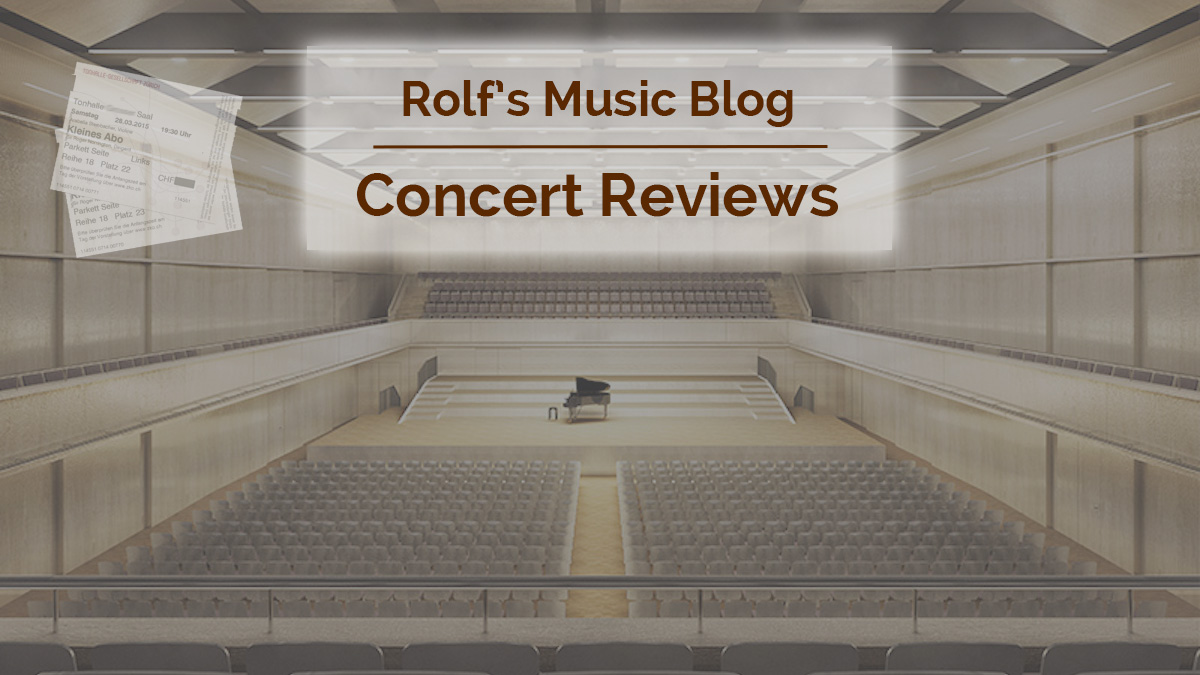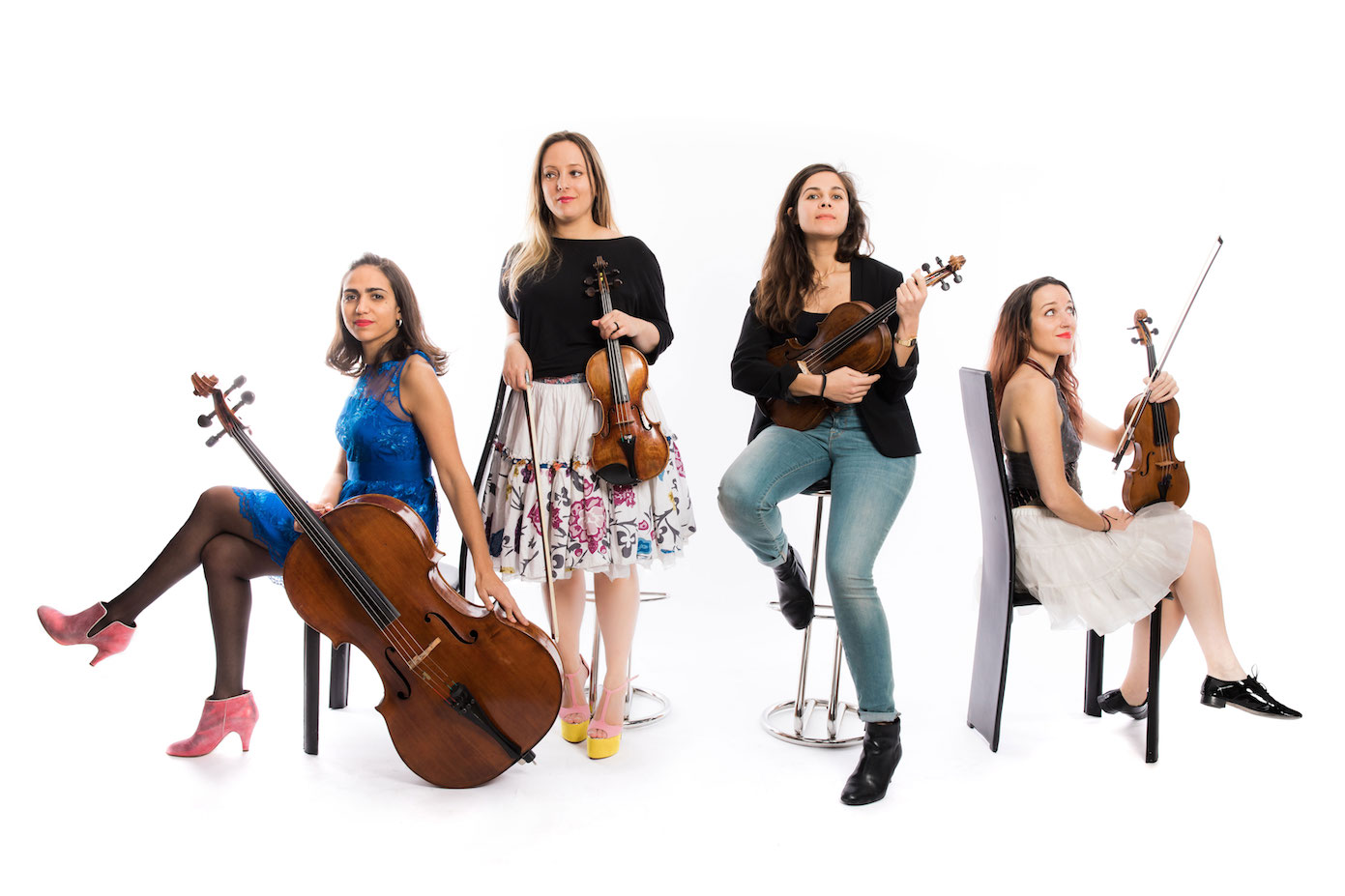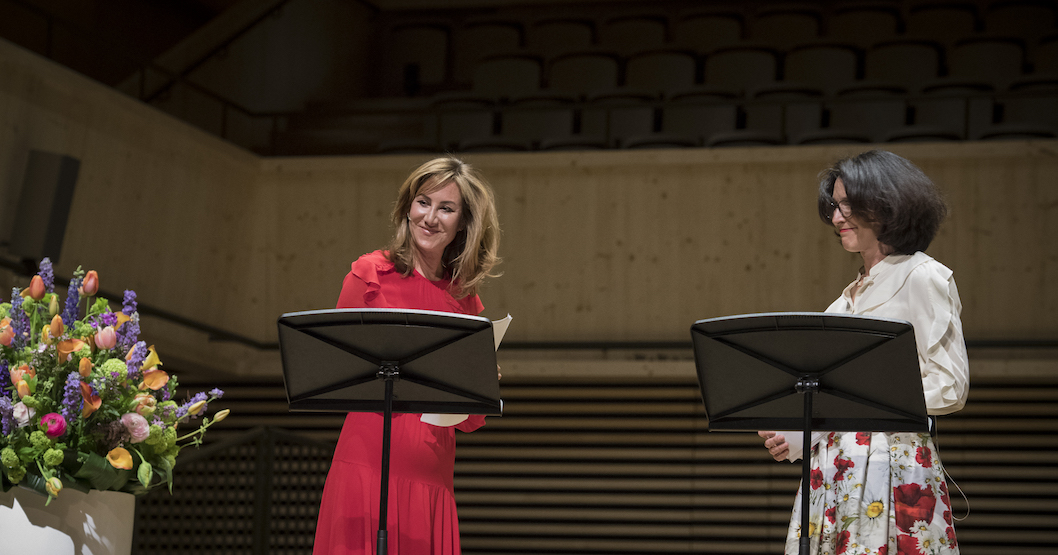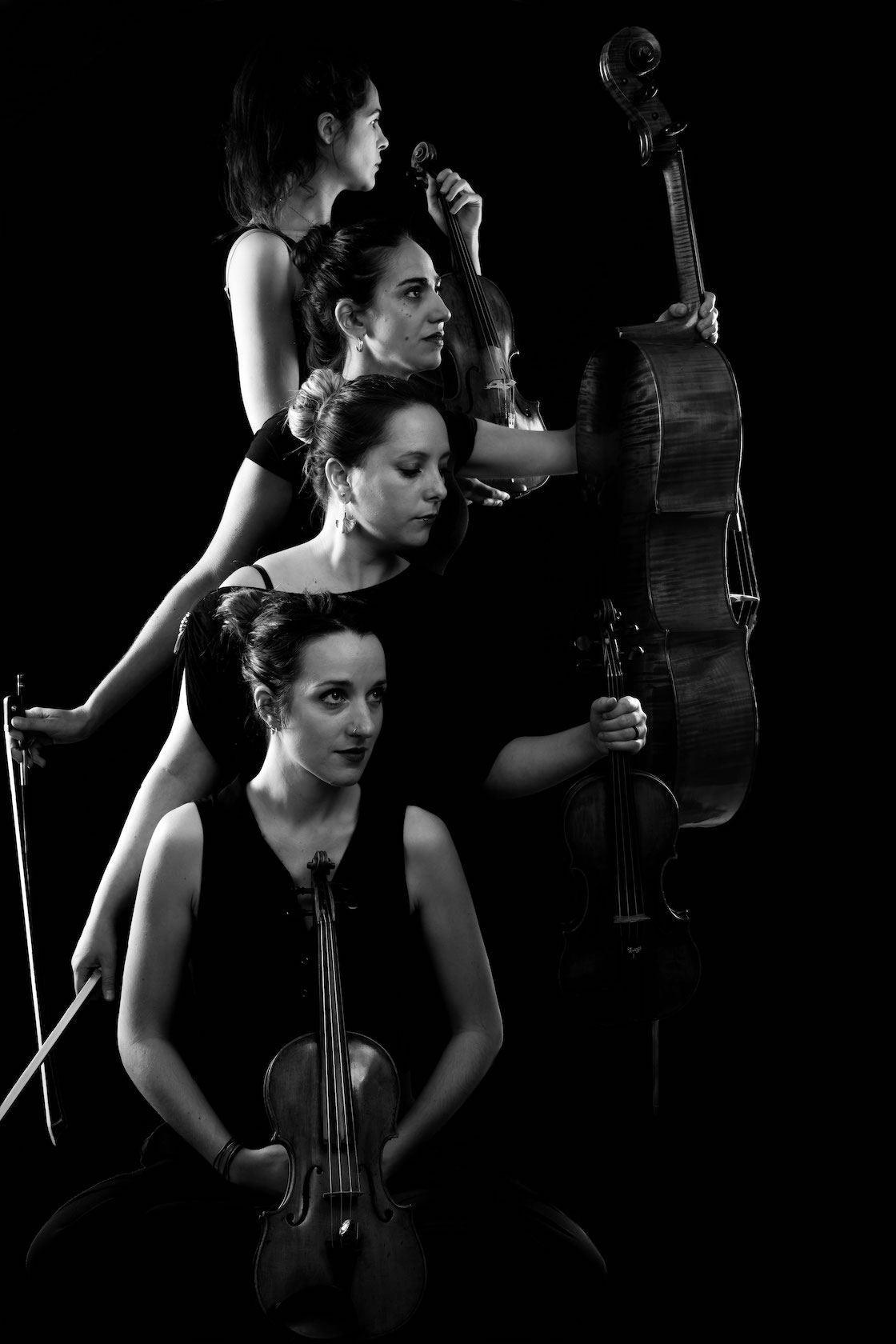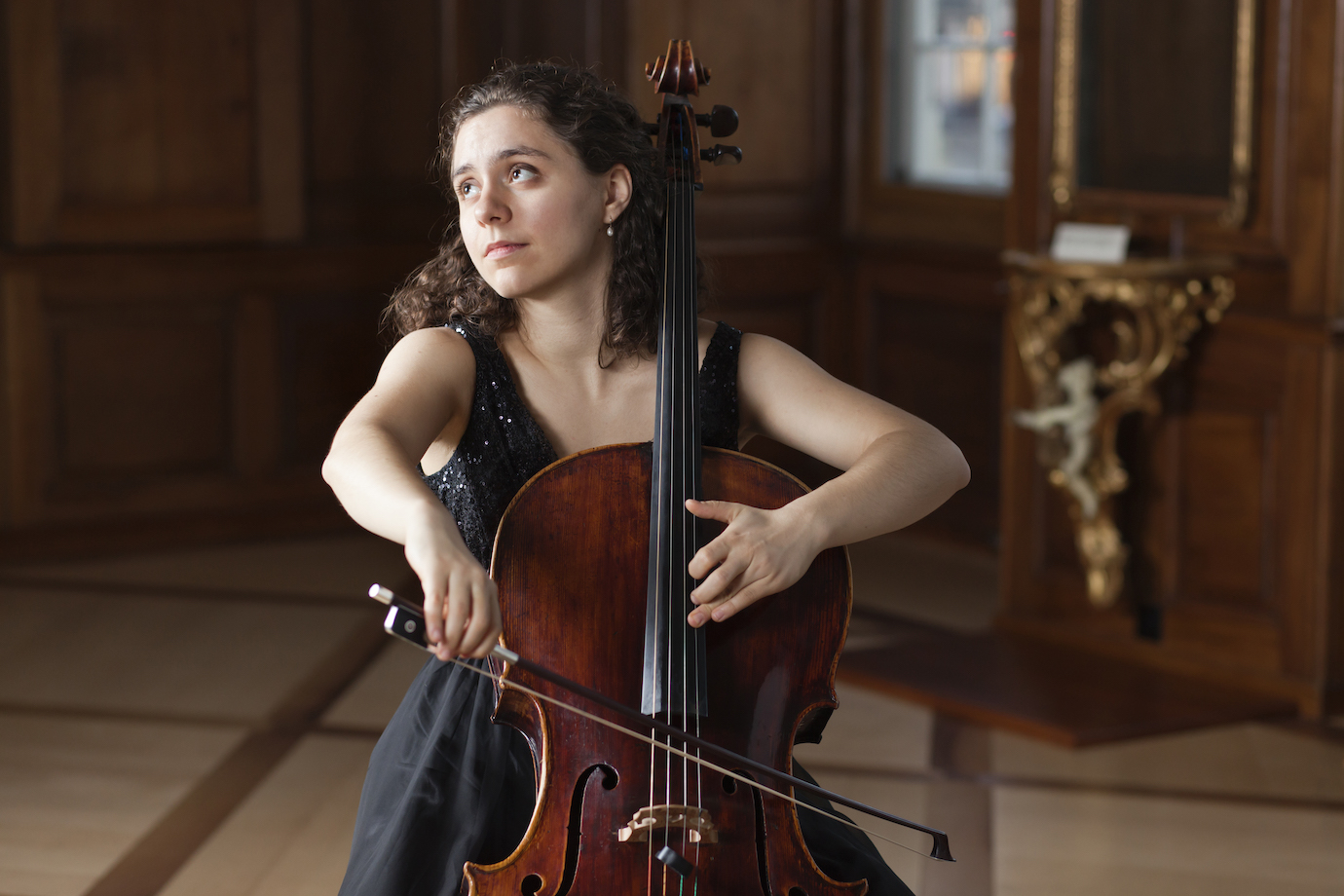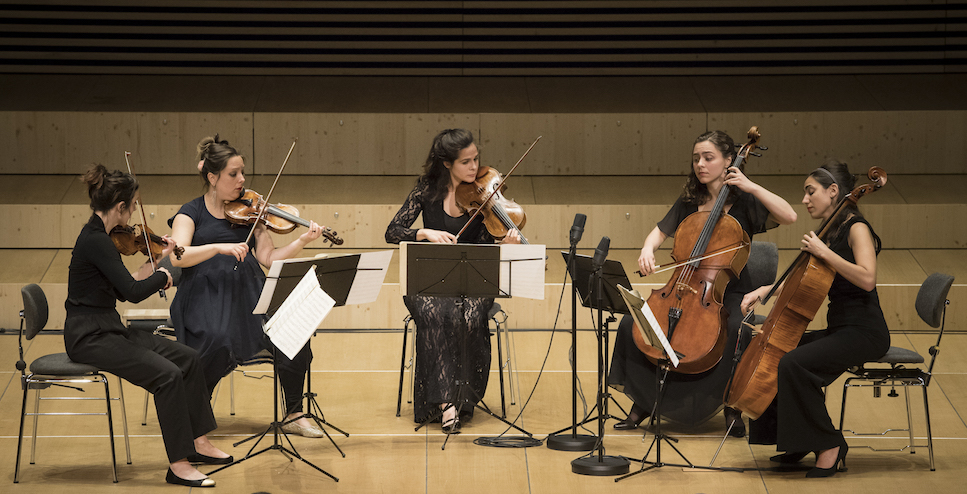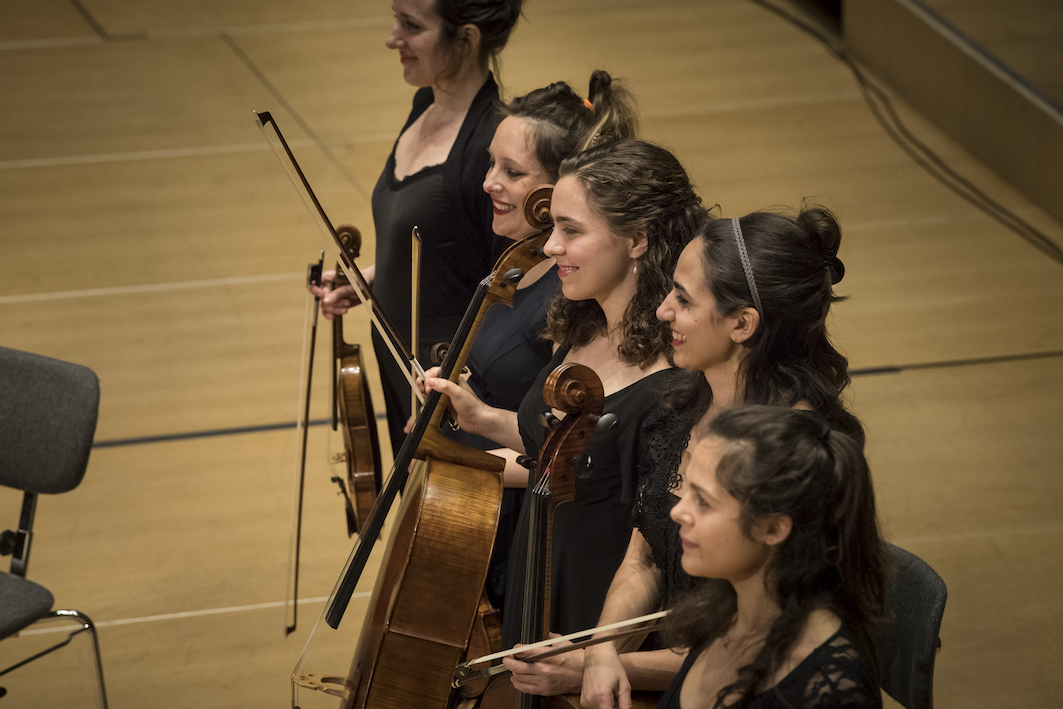Quatuor Zaïde, Chiara Enderle, Lise de la Salle
Haydn / Schumann / Schubert
Tonhalle Maag, Zurich, 2018-04-13

2018-04-17 — Original posting
Table of Contents
Introduction — Foundations
The foundation of this concert at the Tonhalle Maag in Zurich consisted of—two foundations:
- The “Orpheum-Stiftung zur Förderung junger Solisten” (Orpheum Foundation for the Support of Young Artists, founded 1991): in the context of supporting young artists, this Zurich-based organization offers concert opportunities to young artists—mostly symphonic concerts, but occasionally also chamber music events, such as this one.
- The Müller-Möhl Foundation (founded 2012) has a fairly broad scope, in which it cooperates with a large number of organizations and institutions. The main focal areas are
- Education (early child care & education, the future of education, financial literacy)
- Gender Equality (job & family, gender diversity, women returning to work)
- promotion Activities (Switzerland as location for businesses and foundations, philanthropy, emerging businesses).
Foundation Goals in Music
The Müller-Möhl Foundation is actively promoting gender equality, i.e., women in business and arts, etc. as one key area of its activity. It has in the past supported women through the Festival da Jazz St.Moritz (“Women in Jazz”), and in the Lucerne Festival 2016 (“PrimaDonna”).
The Orpheum Foundation, on the other hand, has not actively touted gender equality or women in arts. Nevertheless, over the 27 years since its creation, it has maintained almost perfect gender balance (49% of the supported artists were female). This, however, is not reflecting the general percentage of female artists participating in the classical music scene. As was pointed out in the introduction, in 1987, there were a mere 12% women in German orchestras. In 2018, this percentage has increased to 38%. Hence, we are still fare from gender equality in music.
For this concert now, the two organizations joined forces. They presented a concert exclusively with female artists. Consequently, the introduction was given by two women, Claudia Coninx-Kaczinski (vice president, Orpheum Foundation), and Carolina Müller-Möhl (president and founder, Müller-Möhl Foundation).
The Artists
Quatuor Zaïde (established 2009, see also Wikipedia): this is a young string quartet of four women, residing in Paris. The four members are
- Charlotte Maclet, violin (since December 2017)
- Leslie Boulin Raulet, violin (since September 2014)
- Sarah Chenaf, viola
- Juliette Salmona, cello
The Quatuor Zaïde emerged at the Conservatoire national supérieur de musique et de danse de Paris, where the four founding members did their Master degree.
Recordings
The Quatuor Zaïde was further trained by notable artists. The artists have successfully launched an international concert career. They have already published several recordings on CD (for details see their Web site):
- Janacek & Martinů (2014)
- Haydn, 6 String Quartets, op.50 (2015)
- Franck & Chausson (2017)
The two additional artists joining the Quatuor Zaïde are introduced below, with the respective works that they were playing.
Haydn: String Quartet in F minor, op.20/5, Hob.III/35
Franz Joseph Haydn (1732 – 1809) had been experimenting with music for four string instruments in his early divertimenti op.1 and op.2 (1762 – 1765). A few years later, he wrote the early string quartets op.9 (1769), and op.17 (1771). Then, in 1772, Haydn composed the six string quartets which he published as his op.20. This collection is sometimes called “Sun quartets”. However, this just refers to the emblem of a sun on the front cover in the first edition. It does not indicate a particularly serene or bright atmosphere in this music (definitely not op.20/5!). One could perhaps see the sun as symbol for the key role that the six quartets in op.20 played in establishing the string quartet as a new and popular chamber music genre. The actual break-through for the genre came with op.33 only.
Within op.20, the String Quartet in F minor, op.20/5, Hob.III/35 was the first one that Haydn composed (according to his own catalog). Like most works of this genre, it features four movements:
- Allegro moderato
- Minuetto
- Adagio
- Finale: Fuga a due Soggetti
The Performance
The Quatuor Zaïde—all in festive black, not the jauntily provoking dress style on the first press photo above—played in “natural order”, i.e., violin 1 — violin 2 — viola — cello.
I. Allegro moderato
Right from the first notes, I was fascinated by the clear, fine, softest pp tone, initially with no vibrato at all. However, as restrained as the volume (deliberately, of course) might have been, the Quatuor Zaïde’s playing was all the more intense, focused. It was expressive, even though the vibrato appeared as ornament only. With several of the newer string quartet ensembles, a minimal vibrato might have become the “new normal”. However, this approach is nevertheless demanding and courageous, as it reveals the slightest insecurity in intonation. With the Quatuor Zaïde, the intonation left very little, if anything to wish for.
The other effect of playing without vibrato is that dissonances (of which there are plenty in op.20/5!) appear far sharper, more poignant than in a traditional, “romantic” performance.
The intensity of the Quatuor Zaïde’s playing also showed itself in the musician’s lively body language. At the same time, the ensemble kept eye contact. Charlotte Maclet, the first violinist (and the most recent addition to the group, see above) served as an anchor. At the same time, Haydn gave this voice the clear lead role in this first movement.
The articulation was light, careful, following the score. This all the more highlighted the frequent legato passages in the first voice. It also suited the style of the ensemble’s playing. The tone was very subtle—yet always with character and grip, never neutral. I also had the impression that the instruments fit together very well.
The repeat signs around the exposition were observed, the ones around the development & recap parts were not. Both these choices are just fine. Given the length of the concert, the artists deserve respect for observing almost all of the repeat signs throughout these works!
II. Minuetto
Slow movements, or maybe even more so an intermediate tempo, such as this Minuetto, only too often lead to “belly notes” (unwanted swelling in the middle. Another, frequent “bad habit” is “Nachdrücken” (unwanted swelling when reaching the end of the bow). Both effects are more likely to occur with modern “Tourte” bows. The Quatuor Zaïde used modern bows—but with remarkable control. Neither of the above two effects could be observed—congrats! Beyond this, the ensemble showed remarkable control and subtlety in dynamics.
I liked the little idyl of the Trio: serene music, with the ending crotchets kept short, the staccati in the accompaniment very short, just long enough to allow for well-defined tone & intonation. And the quaver motifs were light and filigree—excellent!
III. Adagio
A beautiful movement in its gently swaying rhythm! The first violin presents the theme, then passes it on to the second violin, thereafter comments / illustrates it with playfully blooming, yet expressive little ornaments. And again I noted the close interaction between the musicians of the Quatuor Zaïde through body language and eye contacts. The calm in the pace was remarkable throughout the movement, as were the excellent agogics. Also, the pauses (general rests) were all filled with esprit and expectation!
IV. Finale: Fuga a due Soggetti
The final movement is a fugue on two subjects: “dry matter”, one might think. However, there it was again, this intensity and constant attention in the pianissimo (Haydn writes sempre sotto voce), as already in the first movement. Here, though, the movement remains at this volume up to the stretto in bar 145. The Quatuor Zaïde exerted remarkable discipline in avoiding unwanted crescendo for this long, first part, keeping the tension throughout. Listening to this was spellbinding, almost forced the audience to stop breathing: people were so attentive that I felt one could have heard a pin drop: excellent!
Schumann: Piano Quintet in E♭ major, op.44
Robert Schumann (1810 – 1856) wrote his Piano Quintet in E♭ major, op.44 in 1842. It’s a key work, not only within Robert Schumann’s chamber music oeuvre, but in the romantic chamber music repertoire altogether. The composition features the following four movements:
- Allegro brillante
- In modo d’una marcia. Un poco largamente – Agitato
- Scherzo: Molto vivace – Trio I & II
- Allegro, ma non troppo
Artist(s)
For this work, the French pianist Lise de la Salle (*1988) joined the Quatuor Zaïde. She was the senior artist in this concert. I have previously written about her and several earlier performances in concert. Therefore, I won’t spend more words on re-introducing her here.
The Performance
Lise de la Salle played on a Steinway D-274. Even though she was occasionally pushing the tempo a bit (see below), Lise de la Salle kept close contact with the musicians in the quartet. I got the impression of an excellent chamber musician. In particular, despite the fully open lid on the concert grand, she carefully kept the acoustic balance with the four string instruments: well done!
I. Allegro brillante
Schumann’s first movement instantly threw the audience into a different world: music full of momentum in the two introductory fanfares. Clearly, the ensemble can also play with full engagement and emphasis, with energy and verve! But then, the piano presented the second theme—p and lyrical, full of longing, love, sighing even: Florestan and Eusebius, or rather Robert and Clara? Lise de la Salle, whom in the past I have mostly heard with virtuosic, rhapsodic music, turns out to have an equal talent at subtle, lyrical playing.
Throughout the movement, I liked the excellent agogics, the rubato, the momentum, the switching between the lyrical “Eusebius” phases and the expressive “Florestan” moments. The latter were almost eruptive, though at all times, the musicians kept the dynamics under control: there was always a good balance between piano and the string instruments (congrats!). And no: the lyrical parts were never too soft (not an “overly female interpretation”), nor were the extroverted parts too forceful (or too testosterone-laden, as with some ensembles!).
My only (minor) quibble: the piano occasionally appeared to push the pace a tad too much (especially in the transitions to the vehement segments, and in some virtuosic segments). In my opinion the final part of the coda was also a bit too pushed: the score specifies con fuoco, but no accelerando. But yes: the ensemble was never dragging!
II. In modo d’una marcia. Un poco largamente – Agitato
As in the slow movement in the Haydn quartet, the musicians kept the pace remarkably calm, resting in itself: excellent. For most of the movement, especially also the lyrical part, the first violin is the lead voice: Charlotte Maclet played very expressively, now with more vibrato, but carefully controlled, still. And again, the rubato, the agogics were excellent. And: there was never even an idea of the tempo running away!
Then, there is the central Agitato part, more virtuosic in the piano, full of excitation, if not nervousness, through the tremolo in the strings, and the “underground boiling” in the piano. Here again, Lise de la Salle was occasionally pushing a bit too much. She certainly was not over-articulating her part. On the other hand, this segment nicely exposed the excellent qualities of the middle string voices, especially the viola.
The movement returns to the initial, calm atmosphere, where the musicians / voices seemed to listen to each other, contemplating questions or statements raised by the first violin. To me, the strength of the performance clearly was in the calm, soft segments.
III. Scherzo: Molto vivace – Trio I & II
The tempo here was very fluent, may be slightly too fast?. The piano was occasionally bordering on being a tad superficial. On the other hand the performance had an aspect of elegance, even moments when it felt ghastly, as it rushed by (the music, not the musicians).
Also the second Trio was at the upper limit in its pace, somewhat fast. This was one of the few segments where the balance seemed to favor the piano. Also, the dynamic contrasts could have been a bit stronger and more direct: to me, the music seemed to lack dynamic structuring. Yes, the score calls for Molto vivace, but it also states marcato, which to me precludes dropping the clarity in favor of a fast tempo. But the latter appears to have impressed the audience, which started applauding!
IV. Allegro, ma non troppo
The last remarks above also apply to the final movement. very fluent, possibly a tad too fast, at least in the fast segments (and once more, this often seemed driven from the piano). Then, there are these “slow” parts (dolce) where Schumann does not change the tempo annotation, but writes an “implicit Adagio” by using very long note values: here, I liked the expressive rubato, with excellent coordination. I was happy about these calmer segments, as they gave me an opportunity to breathe between all the push and excitement in this performance!
Schubert: String Quintet in C major, op.163, D.956
1828, just two months prior to his death, Franz Schubert (1797 – 1828) completed his String Quintet in C major, op.163, D.956. It premiered only in 1850, long after the composer’s premature death. It was published even later, in 1853 only. Quite unusually, this work requires two cellos, rather than two violas. As in many of his late works, the composer did not care about conventions: the dimensions especially of the first two movements are quite large, the entire quintet lasts between 50 and 60 minutes. The four movements are as follows:
- Allegro ma non troppo
- Adagio
- Scherzo: Presto – Trio: Andante sostenuto
- Allegretto
Artist(s)
The biggest work in the program followed after the intermission, and here, the young Swiss cellist Chiara Enderle (*1992) joined the Quatuor Zaïde. Chiara Enderle is an experienced chamber musician. Her parents, Matthias Enderle (violin) and Wendy Enderle-Champney (viola) jointly play in the Zurich-based Carmina Quartet (founded in 1984). The quartet has gained international reputation as one of Switzerland’s prime string quartets. Judging from the ensemble’s preliminary Website, Chiara is about to join her parents’ ensemble as cellist. The ensemble lost its second violinist, Susanne Frank, in September 2017. The quartet is undergoing a re-formation / re-launch.
The Performance
Adding a piano to a string quartet must not be too different from playing a piano concerto with a very small orchestra: a solo instrument and a string quartet as partnership of two radically different entities.
Chiara Enderle, however, was facing a completely different challenge, as here, she needed to integrate herself into an ensemble which (in parts) has been playing together for years, i.e., with instrumentalists who certainly knew each other’s character, reactions, etc. very well. Trying to become an integrated member within very few hours of rehearsal time is virtually impossible. It is for good reason that not infrequently, prominent string quartets have been seeking the help of top, world-class soloists (such as Mstislav Rostropovich) when performing Schubert’s String Quintet.
Here, Chiara Enderle took the role of the second cello (bottom line in the score), but she was sitting between the viola and the first cello: violin 1 — violin 2 — viola — cello 2 (Chiara Enderle) — cello 1. Already this arrangement made her look like an integrated part of the ensemble, into which she also was a good fit age-wise.
The risk was much smaller that the above might suggest, though: Chiara Enderle has grown up in a family of chamber musicians, must have been playing chamber music for most of her young life. Indeed, she appears to be about to become an integral part of her parents’ ensemble, the Carmina Quartet.
Integrating into the Quartet
Very momentarily at the beginning, the quartet may have viewed Chiara Enderle as a “foreign object” that requires special attention. Sure, there have been joint rehearsals. However, how does the addition “work” in concert, in a live situation? However, that really might have been moments only, thereafter it must have been obvious that the extra cellist indeed integrated very well and could be trusted as a full member.
From Chiara Enderle’s perspective, the “live integration process” took a bit longer. For the first minutes, one could see that Chiara was constantly and carefully watching the ensemble, especially the first violinist, Charlotte Maclet, to make sure her playing was in line with that of the quartet (see also the photos above). This phase lasted a few minutes. Thereafter, the cellist had gained enough self-assurance to know that she integrated well, and that it all worked out just fine.
She kept more of an attentive “watching eye” than the others, though, all the way through the performance. Chiara obviously was so well prepared that she played major parts by heart. This allowed her not only to follow Charlotte Maclet, but equally Juliette Salmona at the first cello. From this, it was clear that Chiara is a first-class chamber musician: it was a joy to watch her interaction with the ensemble!
I. Allegro ma non troppo
Throughout this composition, the ensemble exhibited excellent control, especially in the careful and detailed dynamics. The coordination was excellent, the playing alert and attentive at all times, but especially in the soft parts. The tempo felt very natural in this opening movement. For the most part, I really liked the musicians play with the tempo rubato, their agogics. My main quibble was with an occasional tendency to associate a crescendo with (a subtle) accelerando. One example the second theme in bars 32ff, where the falling figure felt a tiny bit fast: in my view, a gradual ritardando is better suited to highlight a key phrase than speeding up.
In this piece, the musicians used distinctly more vibrato than in the Haydn quartet. However, at all times, the vibrato felt natural, rarely ever turned obtrusive. Also, sound-wise, Chiara Enderle integrated very well with the quartet. Her instrument may have sounded a tad rounder, maybe darker, but not to an extent that would have made her stand out in excess. And: some differentiation can only be helpful, after all! One should note that the two cellos are absolutely equivalent. Both get their share of melody lines / cantilenas. There are certainly also segments where the second cello plays a key role as pacemaker—e.g., when it provides the rhythmic foundation through pizzicatos.
There are no secondary roles in Schubert’s score: also the middle voices get their share of intense, harmonious singing. The other thing which I liked was that the ff arpeggio prior to the last p chord remained careful, controlled, was not “abused for show”.
II. Adagio
A beautiful, serene notturno! Again, the ensemble was excellent in keeping the calm, especially in the extended pp (and ppp) parts. The second cello is again crucial in setting the pace with its pizzicato foundation. Through major parts of the movement, the first violin and the second cello carry the emotional, rhythmic and melodic load. Then, in the expressive, dramatic ff part, with its grumbling, rolling triplets, the second cello provides a solid foundation to the quartet: in these moments, the music really seemed to be “for (extra) cello and string quartet”.
After the ff climax, Schubert’s spirit appears to collapse, the music retracts into ppp, with these long general rests—despair, utter tension, or rather the darkness of a gaping abyss? And again, one could have heard a pin drop in the hall, it seemed that people barely dared to breathe! Luckily, careful signs of hope seemed to emerge in the melody line that is shared in a duet between the second cello and the first violin.
The movement is so hard, so much of a challenge in not starting to rush, yet never losing tension. At the same time, the musicians must form harmonious, long (almost endless) tension / phrasing arches. The Quatuor Zaïde and Chiara Enderle did extremely well in this movement. They offered a compelling, both gripping and touching interpretation: a performance completely devoid of unnecessary larmoyancy.
III. Scherzo: Presto – Trio: Andante sostenuto
After the soft ending of the Adagio, the Quatuor Zaïde eruptively launched into the Presto Scherzo, always alert, agile in the accents. Here the pace was rather fast, maybe a tad too fast, to the point where details in the quaver line (primarily in the first violin) started to blur. At this pace, agogics within the motifs were virtually impossible. On the other hand, the ensemble consequently stuck to the selected general pace, making this still an impressive performance.
After the explosive Scherzo, the Trio struck with its sudden change into a twilight atmosphere, with this pallid cantilena, shared between viola and cello II. The music seemed to breathe a mix of resignation and desperate hope. I found the interpretation compelling, particularly in the Trio. That’s actually amazing: Schubert was not too far in age from the artists, when he wrote this music. Yet, there could hardly be a stronger contrast between Schubert’s state of mind, his (pre-)maturity so close to death, and the alertness, the vivacity, and—yes—power of these five young women. OK, the Scherzo part was a tad too fast, but still: chapeau!
IV. Allegretto
The gaps between the movements were getting longer, gradually. There was never any sense of “let’s get done with this!”. Rather, the Quatuor Zaïde demonstrated amazing patience in waiting for the “right” moment, until they—and the audience—were ready for the next movement. On the other hand, I also took this as a sign that the program was very long, maybe overloaded. There was almost 2 hours of music for the quartet, requiring more and more focus, conscious effort and attention. Indeed, in this movement, the intonation started to degrade, which is no less than understandable.
Despite these emerging signs of fatigue: the tempo was really good in this final movement, never exaggerated. There was the occasional, slight acceleration. However, this may well have been intended. Overall, the musicians never lost the tension, relentlessly and consequently followed the path of Schubert’s music, kept shaping the phrases with lively agogics.
There may have been some accelerandi in the main part of the Allegretto, which may or may not haven been intended: admirably (and despite the signs of fatigue), the ensemble resisted accelerating in the crescendo leading into the sudden Più allegro at bar 370. The same with the Più presto (bar 401), leading into a powerful, enthralling ending. Fascinating music, in a gripping interpretation—congratulations!
Conclusion
This was my first encounter with the Quatuor Zaïde, and I have not explored their recordings on CD so far. I obviously cannot comment on their performance with the founding members. Changes in chamber music ensembles are almost inevitable. They may cause disruption, a crisis, a temporary or even permanent downturn in the performance. Here, however, it was astounding to see how much integrated as a team, how coherently the ensemble was performing. Especially as the first violinist has been with the ensemble for a few months only! I can only congratulate the four musicians for their achievement, and wish them all the best for the future of their career!
A Last Note
My seating position was close to the rear end of the left block, front stalls, next to the middle corridor, hence with optimum acoustic balance.

